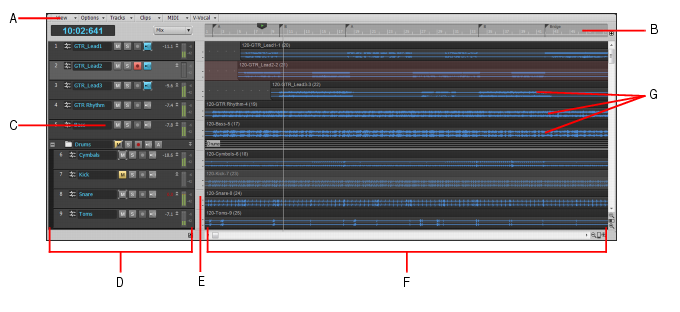The Track view is always visible. It is the main window that you use to create, display, and work with a project. When you open a project file, the Track view is displayed for the project. Closing the Track view closes the project.The Track view is divided into several sections: toolbars (at the top), the Navigator pane, the Video Thumbnails pane, the Track pane, the Clips pane, and the Bus pane. You can change the size of the panes by dragging the vertical or horizontal splitter bars that separate them.Figure 508. The Track viewA. Track view menu B. Time ruler C. Track strips D. Track pane E. Splitter bar F. Clips pane G. ClipsYou can automate most of the controls in the Track view by recording fader movements, drawing envelopes, and creating snapshots.In addition, all of the current track’s controls, plus a few that are only available in the Console view, are contained in the Track Inspector, which is an expanded version of the current track’s controls located on the far left side of the Track view. You can hide or show the Track Inspector by pressing I on your keyboard.Figure 509. Track view menusThe View menu contains the following commands:








































































, which is located at the bottom of the Track view.
You use the buses in the Bus pane to patch in effects, control output volume and pan, and group tracks into subgroups.The Track/Bus Inspector makes it easy to adjust the current track’s (or bus’s) controls, because it’s a greatly expanded version of the current track’s controls that is located on the left side of the Track pane.The Navigator pane, located just above the Track pane, displays the whole length of your project so you can always see an overview of your song, and where the Now time is. The Navigator pane displays all of your project’s tracks. To show or hide the Navigator pane, click the Track view View menu and choose Navigator Show/Hide or press ALT+N. You can drag the splitter bar between the Navigator pane and the Track pane to change its height.The Navigator pane has a green rectangle in it that is an outline of what the Clips pane is currently displaying. If you drag the center of the rectangle around in the pane, it scrolls the Clips pane to the same view. You can drag any of the nodes on the rectangle to zoom the Clips pane in or out. If you click in the Navigator pane, the left border of the rectangle jumps to the spot you clicked, and scrolls the Clips pane to that spot also. If you hold down the CTRL key while you click, the Now time jumps to that spot.Figure 510. The Navigator paneSONAR has a special Accessibility Mode which can be helpful for vision impaired users when working with screen readers (Window-Eyes, JAWS, etc.). The Accessibility Mode is enabled by adding a key to the Windows Registry (WARNING: only do this if you are comfortable with editing the Windows registry; you may want to back up the registry first), and allows screen readers to receive various information from SONAR that may otherwise not be displayed on the screen (names, values, etc.).
Tip - Searching Documentation
Tip: To search for a specific topic, type your search query in the Search Cakewalk.com field at the top right of this page.
When the search results appear, click which product's documentation you would like to search to filter the search results further.
Note - Using Offline Help
Note: If you prefer to always use offline Help, go to Edit > Preferences > File > Advanced in your Cakewalk software and select Always Use Offline Help.
If you are not connected to the internet, your Cakewalk software will default to showing offline help until an internet connection becomes available.






